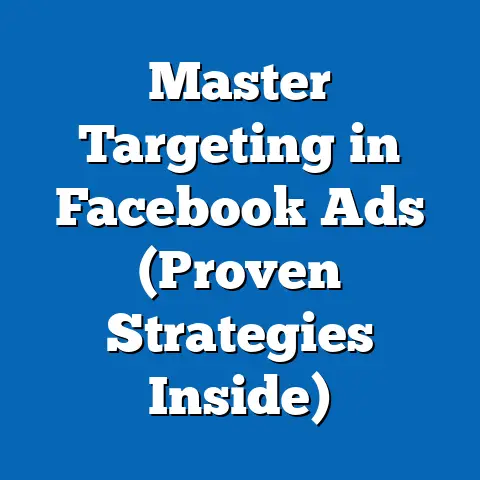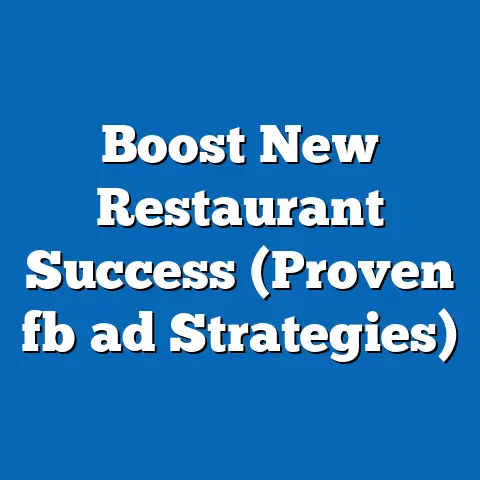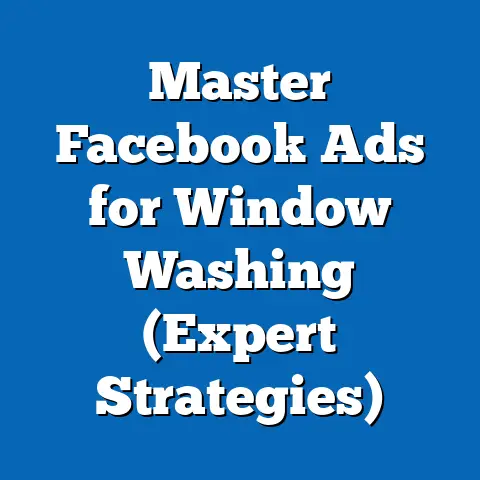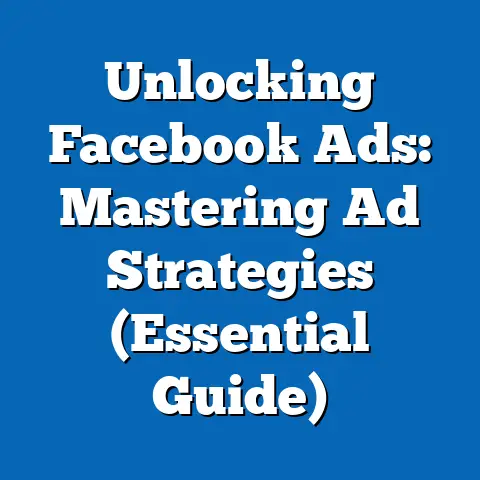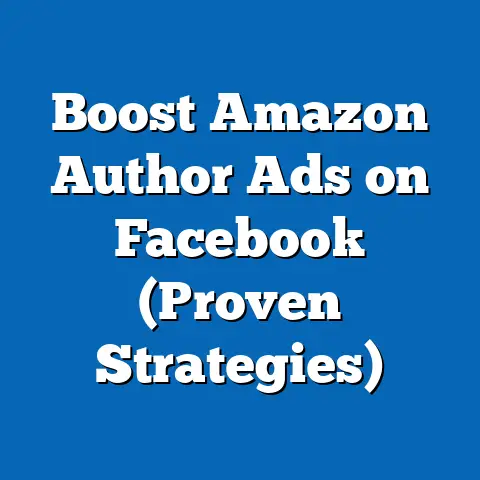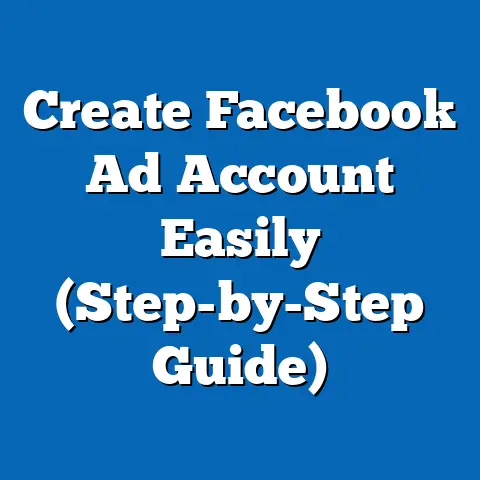Unlocking Insights from Facebook Ads Library (Pro Tactics)
The Facebook Ads Library is a goldmine of information, a treasure trove of advertising strategies laid bare for anyone to explore. It’s a unique tool, offering unprecedented transparency in the world of digital marketing. Unlike the shrouded secrets of advertising campaigns past, the Ads Library democratizes access to what works, what doesn’t, and what your competitors are up to.
This article isn’t just another introduction to the Ads Library. We’re diving deep into pro tactics. I’m talking about strategies that go beyond simple searches and surface-level observations. I want to show you how to leverage this powerful tool to gain actionable insights, optimize your ad campaigns, and stay ahead of the curve in today’s fiercely competitive digital landscape.
Understanding your competitors, spotting emerging industry trends, and identifying underserved market segments are no longer luxuries; they’re necessities. The Facebook Ads Library provides the raw data you need to achieve these goals, but knowing how to interpret that data is the key. I’ve spent countless hours sifting through ads, analyzing strategies, and testing different approaches. In this guide, I’m going to share my hard-earned knowledge and help you unlock the full potential of the Ads Library.
So, what exactly is this magical tool? The Facebook Ads Library is a searchable database of all active ads running across Meta platforms (Facebook, Instagram, Messenger, and Audience Network). It allows you to see the ads being run by any Page, regardless of whether you like or follow that Page. This transparency is invaluable for marketers. You can see what types of ads are being used, who they’re targeting, and how they’re being presented. It’s a constant source of inspiration, competitive intelligence, and trend analysis.
Let’s embark on this journey together and transform the way you approach Facebook advertising.
Section 1: Navigating the Facebook Ads Library
Before we can unleash the power of the Ads Library, we need to understand how to navigate its features. It’s not just about typing in a keyword and hoping for the best. It’s about understanding the interface, mastering the search options, and knowing what types of ads are available.
Accessing the Library
Getting to the Facebook Ads Library is simple. Just head to facebook.com/ads/library in your browser. You’ll be greeted with a search bar and a few basic filtering options.
Here’s the breakdown of the access process:
- Direct Link: The easiest way is to use the direct link above. Bookmark it for easy access!
- Search by Country: The first dropdown allows you to select the country you want to view ads for. This is crucial because ad targeting and content can vary significantly based on location.
- Search by Category: The second dropdown offers two main options:
- All Ads: This shows you all active ads for the Page or keyword you search for.
- Issues, Elections or Politics: This category focuses specifically on ads related to social issues, elections, or political candidates. These ads have additional transparency requirements, such as disclosure of who paid for the ad.
- Search Bar: The search bar is where you enter the name of a Facebook Page or a keyword related to the ads you want to see.
- All Ads: This shows you all active ads for the Page or keyword you search for.
- Issues, Elections or Politics: This category focuses specifically on ads related to social issues, elections, or political candidates. These ads have additional transparency requirements, such as disclosure of who paid for the ad.
Once you’ve entered your search query, hit “Enter” or click the search icon. The Ads Library will display a list of active ads that match your criteria.
My Experience: I remember when I first started using the Ads Library, I was overwhelmed by the sheer amount of information. I’d type in a broad keyword like “marketing” and get thousands of results. It took me a while to learn how to refine my searches and use the filters effectively. Don’t make the same mistake I did. Start with specific keywords and Page names to narrow your focus and get more relevant results.
Understanding the Interface
The Ads Library interface is relatively straightforward, but understanding its nuances is key to extracting maximum value. Here’s a breakdown of the key elements:
- Ad Preview: Each ad is displayed with a preview that includes the ad creative (image or video), ad copy, and call-to-action button.
- Page Information: The name of the Facebook Page running the ad is displayed prominently, along with a link to the Page.
- Ad Details: Clicking on an ad reveals more details, such as:
- Start Date: When the ad first started running.
- Platforms: Which platforms the ad is running on (Facebook, Instagram, Messenger, Audience Network).
- Impressions (for political ads): Estimated range of impressions delivered (only available for ads related to issues, elections, or politics).
- Filtering Options: The left-hand sidebar provides additional filtering options:
- Date Range: Filter ads by the date they started running.
- Platforms: Filter ads by the platforms they’re running on.
- Sorting Options: You can sort ads by “Most Recent” or “Relevance.”
- Start Date: When the ad first started running.
- Platforms: Which platforms the ad is running on (Facebook, Instagram, Messenger, Audience Network).
- Impressions (for political ads): Estimated range of impressions delivered (only available for ads related to issues, elections, or politics).
- Date Range: Filter ads by the date they started running.
- Platforms: Filter ads by the platforms they’re running on.
Pro Tip: Pay close attention to the “Start Date” of an ad. If an ad has been running for a long time, it’s likely performing well. This is a strong indicator that the ad copy, creative, and targeting are effective.
Types of Ads Available
The Facebook Ads Library showcases a variety of ad formats, each with its own strengths and weaknesses. Understanding these formats is crucial for analyzing competitor strategies and identifying opportunities for your own campaigns. Here are some of the most common ad formats you’ll encounter:
- Image Ads: Simple ads featuring a single image and accompanying text. These are often used for brand awareness or to promote specific products.
- Video Ads: Ads that use video to capture attention and convey a message. Video ads are highly engaging and can be used for a variety of purposes, from product demos to storytelling.
- Carousel Ads: Ads that display multiple images or videos in a scrollable format. These are ideal for showcasing a range of products or highlighting different aspects of a single product.
- Collection Ads: Ads that combine a main image or video with a grid of smaller product images. These are designed to drive sales by allowing users to browse and purchase products directly from the ad.
- Lead Generation Ads: Ads that include a form for users to submit their contact information. These are used to generate leads for businesses in various industries.
Actionable Takeaway: Take some time to explore the different ad formats in the Ads Library. Pay attention to how different businesses are using each format and consider how you can adapt these strategies for your own campaigns.
Section 2: Competitive Analysis
Now that we know how to navigate the Ads Library, let’s put it to use for competitive analysis. This is where the real magic happens. By carefully analyzing your competitors’ ads, you can gain valuable insights into their marketing strategies, target audiences, and overall effectiveness.
Identifying Competitors
The first step in competitive analysis is identifying your direct competitors. This may seem obvious, but it’s important to be thorough. Don’t just think about the companies that sell the same products or services as you. Consider companies that target the same audience or address the same needs.
Here are a few strategies for identifying competitors using the Ads Library:
- Keyword Search: Search for keywords related to your industry or product category. Pay attention to the Facebook Pages that are running ads for these keywords. These are likely your competitors.
- Customer Research: Ask your customers who else they considered before choosing your product or service. Then, search for those companies in the Ads Library.
- Industry Associations: Check out the websites of industry associations or trade groups. These often list member companies, which can be a good starting point for your competitor research.
My Story: I once worked with a client who was convinced they had no direct competitors. They were in a niche industry and believed their product was completely unique. However, after doing some research in the Ads Library, we discovered several companies that were targeting the same audience with similar solutions. This was a wake-up call for my client, and it helped them to refine their marketing strategy and differentiate themselves from the competition.
Analyzing Competitor Ads
Once you’ve identified your competitors, it’s time to start analyzing their ads. This involves looking at the ad copy, visuals, and calls to action (CTAs) to understand their messaging, targeting, and overall strategy.
Here’s a detailed approach to analyzing competitor ads:
Ad Spend Insights
While the Ads Library doesn’t provide exact ad spend figures, you can get a sense of how much your competitors are spending based on the frequency and type of ads they’re running.
Here are a few factors to consider:
- Number of Ads: The more ads a competitor is running, the more likely they are spending a significant amount of money.
- Ad Format: Video ads and collection ads tend to be more expensive than image ads.
- Ad Duration: If an ad has been running for a long time, it’s likely performing well and the competitor is willing to continue investing in it.
- Platform Coverage: If a competitor is running ads on multiple platforms (Facebook, Instagram, Messenger, Audience Network), they’re likely spending more than if they’re only running ads on one platform.
Important Note: These are just estimates. It’s impossible to know exactly how much your competitors are spending on Facebook ads without access to their ad accounts. However, these insights can give you a general idea of their marketing budget and priorities.
Actionable Takeaway: Create a spreadsheet to track your competitors’ ads, including their ad copy, visuals, CTAs, and estimated ad spend. This will give you a comprehensive overview of their marketing strategies and help you identify opportunities for your own campaigns.
Section 3: Identifying Trends and Opportunities
The Facebook Ads Library isn’t just a tool for competitive analysis. It’s also a powerful resource for identifying emerging trends and opportunities in your industry. By monitoring the types of ads that are being run, the messaging that’s being used, and the products that are being promoted, you can gain valuable insights into the direction your industry is heading.
Spotting Industry Trends
One of the most valuable uses of the Ads Library is to identify emerging trends in your industry. This can help you to stay ahead of the curve and adapt your marketing strategies accordingly.
Here are a few ways to use the Ads Library to spot industry trends:
- Keyword Monitoring: Track the frequency of certain keywords in ad copy. If you see a sudden increase in the use of a particular keyword, it could be a sign that a new trend is emerging.
- Visual Analysis: Pay attention to the types of visuals that are being used in ads. Are there any new design trends or image styles that are becoming popular?
- Product Promotion: Monitor the types of products that are being promoted in ads. Are there any new products or services that are gaining traction?
- Messaging Analysis: Analyze the messaging that’s being used in ads. Are there any new value propositions or pain points that are being addressed?
Example: Let’s say you’re in the sustainable fashion industry. You notice a sudden increase in the use of keywords like “eco-friendly,” “ethical sourcing,” and “recycled materials” in ad copy. You also see more ads featuring visuals of natural landscapes and models wearing clothing made from sustainable materials. This could be a sign that consumers are becoming more interested in sustainable fashion, and you should consider incorporating these elements into your own marketing.
Seasonal Insights
Seasonal campaigns are a staple of many industries, and the Ads Library can provide valuable insights into how your competitors are approaching these campaigns. By analyzing ads that run during specific holidays or seasons, you can learn what types of messaging, visuals, and CTAs are most effective.
Here are a few tips for leveraging seasonal insights from the Ads Library:
- Historical Data: Look at ads that ran during the same season in previous years. This can give you a sense of what worked well in the past.
- Competitor Analysis: Monitor your competitors’ seasonal campaigns in real-time. Pay attention to the types of promotions they’re running and the messaging they’re using.
- Creative Inspiration: Use the Ads Library to find inspiration for your own seasonal ad creatives. Look for ads that are visually appealing and effectively convey the holiday spirit.
My Experience: I once used the Ads Library to analyze Christmas ad campaigns in the toy industry. I noticed that many successful ads featured families playing together and emphasized the emotional connection between parents and children. I used this insight to create a Christmas ad campaign for a client that focused on the joy of giving and the importance of family time. The campaign was a huge success, generating a significant increase in sales.
Finding Gaps in the Market
In addition to identifying trends, the Ads Library can also help you to find gaps in the market. By looking for areas where there’s a lack of advertising activity, you can identify opportunities to reach underserved audiences or promote products or services that are not currently being marketed effectively.
Here are a few tactics for finding gaps in the market using the Ads Library:
Actionable Takeaway: Regularly monitor the Ads Library for emerging trends and opportunities in your industry. This will help you to stay ahead of the curve and adapt your marketing strategies accordingly.
Section 4: Crafting Better Ads
The ultimate goal of using the Facebook Ads Library is to create better ads that generate more results. By learning from top performers, mastering effective copywriting techniques, and incorporating visually appealing design elements, you can significantly improve the performance of your ad campaigns.
Learning from Top Performers
One of the most effective ways to improve your own ads is to study the ads of top performers in your industry. By analyzing what makes these ads successful, you can gain valuable insights into what resonates with your target audience and what drives conversions.
Here are a few steps for learning from top performers:
- Identify Top Performers: Use the Ads Library to identify the top-performing ads in your industry. Look for ads that have been running for a long time, have a high level of engagement (likes, comments, shares), and effectively convey a clear message.
- Analyze Ad Copy: Carefully analyze the ad copy of top-performing ads. Pay attention to the tone, style, value proposition, and call to action. What makes the ad copy so compelling?
- Examine Visual Elements: Examine the visual elements of top-performing ads. Are the images or videos high-quality and visually appealing? Do they effectively convey the message of the ad?
- Identify Targeting Strategies: Try to infer the targeting strategies of top-performing ads. Who is the ad trying to reach? What interests, behaviors, or demographics are they targeting?
- Adapt and Implement: Adapt the strategies and techniques used by top performers to your own ads. Don’t just copy their ads verbatim. Instead, use their ads as inspiration and adapt their strategies to fit your own brand and target audience.
Example: Let’s say you’re selling online courses. You find a top-performing ad for a competitor’s course that features a video testimonial from a satisfied student. The student talks about how the course helped them to achieve their career goals and transform their life. You can use this insight to create your own video testimonial ad, featuring satisfied students who have benefited from your courses.
Copywriting Techniques
Effective copywriting is essential for creating ads that capture attention, engage your target audience, and drive conversions. The Facebook Ads Library can provide valuable insights into effective copywriting techniques.
Here are a few copywriting techniques that you can learn from the Ads Library:
- Use Strong Headlines: The headline is the first thing people see, so it needs to be attention-grabbing and relevant to your target audience. Look for ads with headlines that use strong keywords, ask a question, or make a bold statement.
- Highlight Benefits, Not Features: Focus on the benefits that your product or service provides, rather than just listing its features. What problems does it solve? How will it improve your customers’ lives?
- Use Social Proof: Incorporate social proof into your ad copy to build trust and credibility. This can include testimonials, reviews, or data that demonstrates the effectiveness of your product or service.
- Create a Sense of Urgency: Use language that creates a sense of urgency, such as “Limited Time Offer” or “Sale Ends Soon.” This can encourage people to take action before it’s too late.
- Use a Clear Call to Action: Tell people exactly what you want them to do. Use a clear and concise call to action, such as “Learn More,” “Shop Now,” or “Sign Up.”
My Secret: One of my favorite copywriting techniques is to use the “problem-agitation-solution” (PAS) formula. This involves identifying a problem that your target audience is facing, agitating the problem by highlighting its negative consequences, and then presenting your product or service as the solution. This formula is highly effective for capturing attention and driving conversions.
Visual Elements
Visual elements play a crucial role in the success of Facebook ads. A visually appealing ad can capture attention, convey your message effectively, and create a positive impression of your brand.
Here are a few design elements that can enhance ad performance:
- High-Quality Images and Videos: Use images and videos that are high-resolution, visually appealing, and relevant to your target audience.
- Eye-Catching Colors: Use colors that are eye-catching and consistent with your brand.
- Clear and Concise Text: Use text that is easy to read and understand. Avoid using too much text in your visuals.
- Branding Elements: Incorporate your brand’s logo, colors, and fonts into your visuals.
- Mobile Optimization: Design your visuals to be mobile-friendly. Most Facebook users access the platform on their mobile devices, so it’s important to ensure that your visuals look good on small screens.
Actionable Takeaway: Experiment with different visual elements to see what works best for your target audience. Use A/B testing to compare different images, videos, and design styles.
Section 5: Testing and Iteration
Crafting effective Facebook ads is not a one-time task. It’s an ongoing process of testing, iteration, and optimization. The Facebook Ads Library can be a valuable resource for informing your testing strategies and helping you to continuously improve the performance of your ad campaigns.
Creating a Test Strategy
Before you start testing different ad elements, it’s important to develop a clear test strategy. This will help you to stay organized, track your results, and make informed decisions about your ad campaigns.
Here are a few steps for creating a test strategy:
- Define Your Goals: What do you want to achieve with your testing? Do you want to improve your click-through rate, conversion rate, or return on ad spend?
- Identify Key Variables: What variables do you want to test? This could include headlines, ad copy, images, videos, calls to action, or targeting options.
- Develop Hypotheses: For each variable you want to test, develop a hypothesis about what you expect to happen. For example, “I believe that using a video testimonial will increase my conversion rate by 10%.”
- Set Up A/B Tests: Use Facebook’s A/B testing feature to create different versions of your ads, each with a different value for the variable you’re testing.
- Track Your Results: Carefully track the performance of each ad version. Pay attention to metrics like click-through rate, conversion rate, and cost per conversion.
- Analyze Your Data: Analyze your data to determine which ad version performed best. Use the results to inform your future ad campaigns.
Pro Tip: When testing different ad elements, only change one variable at a time. This will allow you to isolate the impact of each variable and determine what’s truly driving performance.
Iterating Based on Insights
Once you’ve gathered data from your A/B tests, it’s time to iterate based on the insights you’ve gained. This involves making changes to your ad campaigns based on what you’ve learned from your testing.
Here are a few ways to iterate based on insights from the Ads Library and your own testing:
- Refine Your Ad Copy: Use the insights you’ve gained from your testing to refine your ad copy. Experiment with different headlines, value propositions, and calls to action.
- Improve Your Visuals: Use the insights you’ve gained from your testing to improve your visuals. Experiment with different images, videos, and design styles.
- Optimize Your Targeting: Use the insights you’ve gained from your testing to optimize your targeting. Experiment with different interests, behaviors, and demographics.
- Adjust Your Budget: Adjust your budget based on the performance of your ad campaigns. Allocate more budget to the campaigns that are performing well and less budget to the campaigns that are underperforming.
My Biggest Mistake: Early in my career, I made the mistake of assuming that I knew what would work best for my clients. I didn’t bother to test different ad elements or iterate based on data. As a result, my ad campaigns were often underperforming. It wasn’t until I started embracing a data-driven approach that my ad campaigns started to generate significant results.
Measuring Success
It’s crucial to measure the success of your changes effectively. Here are some key metrics to track when implementing new strategies inspired by the Ads Library:
- Click-Through Rate (CTR): Measures the percentage of people who see your ad and click on it. A higher CTR indicates that your ad is relevant and engaging to your target audience.
- Conversion Rate: Measures the percentage of people who click on your ad and complete a desired action, such as making a purchase or filling out a form. A higher conversion rate indicates that your ad is effectively driving conversions.
- Cost Per Conversion (CPC): Measures the cost of acquiring one conversion. A lower CPC indicates that your ad is efficiently driving conversions.
- Return on Ad Spend (ROAS): Measures the revenue generated for every dollar spent on advertising. A higher ROAS indicates that your ad campaign is profitable.
Actionable Takeaway: Continuously test, iterate, and optimize your ad campaigns based on data and insights from the Facebook Ads Library. This is the key to achieving long-term success with Facebook advertising.
Conclusion
We’ve covered a lot of ground in this guide, from navigating the Facebook Ads Library to crafting better ads and measuring success. The key takeaway is that the Ads Library is a powerful tool that can help you to unlock valuable insights and improve the performance of your Facebook ad campaigns.
Here’s a quick recap of the essential tactics we discussed:
- Master the Ads Library Interface: Understand how to search, filter, and analyze ads.
- Conduct Competitive Analysis: Identify your competitors and analyze their ad strategies.
- Spot Industry Trends: Monitor the Ads Library for emerging trends and opportunities.
- Learn from Top Performers: Study the ads of top performers in your industry.
- Test and Iterate: Continuously test, iterate, and optimize your ad campaigns based on data and insights.
I encourage you to actively utilize the Facebook Ads Library as a regular part of your advertising strategy. Don’t just use it once in a while when you’re feeling stuck. Make it a habit to check the Ads Library regularly to stay informed about the latest trends, competitor strategies, and effective ad techniques.
Knowledge is power in the ever-evolving landscape of digital marketing. The Facebook Ads Library provides you with the knowledge you need to stay ahead of the curve and achieve your advertising goals.
As we look to the future of advertising, transparency will continue to play an increasingly important role. The Facebook Ads Library is a testament to this trend, and it empowers marketers to make data-driven decisions, foster innovation, and drive competition. Embrace this transparency, leverage the insights it provides, and unlock the full potential of your Facebook ad campaigns.

